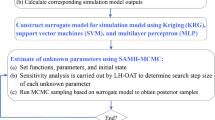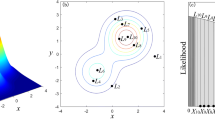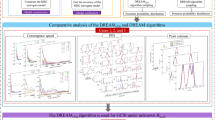Abstract
Identification of groundwater contamination sources, as a solution to an inverse problem, is mainly based on simulation optimization methods. However, the establishment and solution of an optimization model are extremely complicated for the inverse problem, where many decision variables need to be identified. Combining simulation optimization methods with other mathematical methods can effectively avoid this shortcoming. In order to identify features of contamination sources, the Kalman filter is combined with a mixed-integer nonlinear programming optimization model (MINLP). Firstly, the Kalman filter is improved by U-D decomposition (a matrix decomposition method) to identify the number and approximate locations of real contamination sources among potential contamination sources. A 0–1MINLP solution is then employed to identify the accurate location and release history of the contamination source. Kriging is used to produce a surrogate model for the numerical simulation model. The surrogate model approximates the numerical simulation model, which can be embedded in the 0–1MINLP instead of the numerical simulation model and it can be called directly during the iteration of the optimization model, thereby avoiding manually coupling the numerical simulation model with the optimization model during the solution process. Results demonstrate that the improved Kalman filter exhibits better numerical stability, where it can effectively avoid the filter divergence problem as well as solve the number and approximate locations of contamination sources in the inverse identification problem. The accurate location and release history of the contamination source can be effectively identified by using the 0–1MINLP.
Résumé
L’identification des sources de contamination des eaux souterraines, comme solution à un problème inverse, est principalement basée sur des méthodes d’optimisation de la simulation. Toutefois, l’établissement et la résolution d’un modèle d’optimisation sont extrêmement compliqués pour le problème inverse, dans lequel beaucoup de variables décisionnelles doivent être répertoriées. Combiner des méthodes d’optimisation de la simulation et d’autres méthodes mathématiques peut réellement éviter cet écueil. Afin de définir les caractéristiques des sources de contamination, le filtre de Kalman est combiné avec un modèle d’optimisation par programmation non -linéaire de nombres entiers mélangés (MOPNL). Tout d’abord, le filtre de Kalman est amélioré par une décomposiation U-D (une méthode de décompostion matricielle) afin d’identifier le nombre et la localisation approximative des sources de contamination réelles parmi les sources de contamination potentielles. Une solution 0–1 MOPNL est ensuite utilisée pour décrire la localisation exacte et l’historique des émissions de la source de contamination. Un krigeage est mis en oeuvre pour créer un modèle de substitution au modèle de simulation numérique. Le modèle de substitution, qui se rapproche du modèle de simulation numérique, peut être implanté à sa place dans le 0–1 MOPNL et peut être appelé directement durant l’itération du modèle d’optimisation, évitant ainsi le couplage manuel du modèle de simulation numérique et du modèle d’optimisation pendant le processus de résolution. Les résultats démontrent que le filtre de Kalman amélioré fait preuve d’une meilleure stabilité numérique, dans la mesure où il peut réellement éviter le problème de divergence du filtre aussi bien qu’éclairer le nombre et la localisation approximative des sources de contamination dans le problème inverse d’identification. La localisation exacte et l’historique des émissions de la source de contamination peuvent être effectivement définis en utilisant 0–1 MOPNL.
Resumen
La identificación de fuentes de contaminación de aguas subterráneas, como solución a un problema inverso, se basa principalmente en métodos de optimización de simulación. Sin embargo, el establecimiento y la solución de un modelo de optimización son extremadamente complicados para el problema inverso, donde es necesario identificar muchas variables de decisión. La combinación de métodos de optimización de simulación con otros métodos matemáticos puede evitar eficazmente esta deficiencia. Para identificar las características de las fuentes de contaminación, el filtro Kalman se combina con un modelo de optimización de programación no lineal de números enteros mixtos (MINLP). En primer lugar, el filtro Kalman se mejora con la descomposición U-D (un método de descomposición matricial) para identificar el número y la ubicación aproximada de las fuentes reales de contaminación entre las posibles fuentes de contaminación. Luego se emplea una solución 0-1MINLP para identificar la ubicación exacta y el historial de liberación de la fuente de contaminación. Kriging se utiliza para producir un modelo sustituto para el modelo de simulación numérica. El modelo sustituto se aproxima al modelo de simulación numérica, que puede ser embebido en el 0-1MINLP en lugar del modelo de simulación numérica y puede ser llamado directamente durante la iteración del modelo de optimización, evitando así el acoplamiento manual del modelo de simulación numérica con el modelo de optimización durante el proceso de solución. Los resultados demuestran que el filtro Kalman mejorado exhibe una mejor estabilidad numérica, donde puede evitar eficazmente el problema de divergencia del filtro, así como resolver el número y la ubicación aproximada de las fuentes de contaminación en el problema de identificación inversa. La ubicación exacta y el historial de liberación de la fuente de contaminación pueden ser identificados efectivamente usando el 0-1MINLP.
摘要
模拟优化方法是解决地下水污染源识别这类反问题的主要方法之一。然而,对于具有多决策变量待于识别的反问题,优化模型的建立和求解都十分复杂。将模拟优化方法和其它数学方法相结合,可以有效地避免这一缺点。为了对地下水污染源的特征进行识别,将卡尔曼滤波器与混合整数非线性规划结合运用。首先,利用U-D分解(矩阵分解法)对卡尔曼滤波器进行改进,以识别潜在污染源中真实污染源的个数和大致位置。然后,应用0–1混合整数非线性优化模型识别污染源的准确位置和释放历史。运用克里金方法建立数值模拟模型的替代模型。替代模型在功能上逼近数值模拟模型,可以代替模拟模型嵌入于0–1混合整数非线性优化模型,在优化模型求解的迭代过程中替代模型可以直接被调用,从而避免在求解过程中,人工重复将模拟模型与优化模型耦合的操作。结果表明改进的卡尔曼滤波器具有更好的数值稳定性,可有效避免滤波发散的缺点,解决污染源反演识别研究中个数和大致位置识别问题。应用0–1混合整数非线性优化模型,可以有效识别出污染源的准确位置和释放历史。
Resumo
A identificação de fontes de contaminação de águas subterrâneas, a partir de uma solução de problema inverso, baseia-se principalmente em métodos de otimização de simulação. No entanto, estabelecer e solucionar um modelo de otimização são extremamente complicados para o problema inverso, já que há muitas variáveis de decisão para ser identificadas. Combinar métodos de otimização de simulação com outros métodos matemáticos pode efetivamente evitar esse problema. Para identificar características de fontes de contaminação, o filtro de Kalman é combinado com um modelo de otimização de programação não-linear inteira mista (MINLP). Em primeiro lugar, o filtro de Kalman é melhorado pela decomposição U-D (um método de decomposição de matriz) para identificar o número e a localização aproximada de fontes reais de contaminação entre fontes potenciais de contaminação. Uma solução 0–1MINLP é então empregada para identificar a localização precisa e o histórico de liberação da fonte de contaminação. Krigagem é usada para produzir um metamodelo para o modelo de simulação numérica. O metamodelo aproxima o modelo de simulação numérica, que pode ser incorporado ao modelo 0–1MINLP ao invés do modelo numérico de simulação, e pode ser chamado diretamente durante a iteração do modelo de otimização, evitando assim o acoplamento manual entre o modelo de simulação numérica e o modelo de otimização durante o processo de solução. Os resultados demonstram que o filtro de Kalman melhorado apresenta melhor estabilidade numérica, onde pode efetivamente evitar o problema de divergência do filtro, bem como resolver o número e localização aproximada das fontes de contaminação no problema de identificação inversa. A localização precisa e o histórico de versões da fonte de contaminação podem ser efetivamente identificados usando o 0–1MINLP.










Similar content being viewed by others
References
Ababou R, Bagtzoglou AC, Mallet A (2010) Anti-diffusion and source identification with the ‘RAW’ scheme: a particle-based censored random walk. Environ Fluid Mech 10(1):41–76. https://doi.org/10.1007/s10652-009-9153-4
Atmadja J, Bagtzoglou AC (2001) State of the art report on mathematical methods for groundwater pollution source identification. Environ Forensic 2(3):205–214. https://doi.org/10.1006/enfo.2001.0055
Ayvaz MT (2010) A linked simulation–optimization model for solving the unknown groundwater pollution source identification problems. J Contam Hydrol 117(1–4):46–59. https://doi.org/10.1016/j.jconhyd.2010.06.004
Butera I, Tanda MG, Zanini A (2013) Simultaneous identification of the pollutant release history and the source location in groundwater by means of a geostatistical approach. Stoch Env Res Risk A 27(5):1269–1280. https://doi.org/10.1007/s00477-012-0662-1
Chaubey J, Kashyap D (2017) A data parsimonious model for capturing snapshots of groundwater pollution sources. J Contam Hydrol 197:17–28. https://doi.org/10.1016/j.jconhyd.2016.12.008
Chen Y, Oliver DS (2010) Cross-covariances and localization for EnKF in multiphase flow data assimilation. Comput Geosci 14(4):579–601. https://doi.org/10.1007/s10596-009-9174-6
Chu HB, Lu WX (2015) Adaptive kriging surrogate model for the optimization design of a dense non-aqueous phase liquid-contaminated groundwater remediation process. Water Sci Technol Water Supply 15(2):263. https://doi.org/10.2166/ws.2014.108
Coetzee W, Coetzer RL, Rawatlal R (2012) Response surface strategies in constructing statistical bubble flow models for the development of a novel bubble column simulation approach. Comput Chem Eng 36:22–34. https://doi.org/10.1016/j.compchemeng.2011.07.014
Cowan MJ (2008) Breaking short playfair ciphers with the simulated annealing algorithm, Cptologia. (1):71–83. https://doi.org/10.1080/01611190701743658
Datta B, Chakrabarty D, Dhar A (2009) Simultaneous identification of unknown groundwater pollution sources and estimation of aquifer parameters. J Hydrol 376(1–2):48–57. https://doi.org/10.1016/j.jhydrol.2009.07.014
Datta B, Chakrabarty D, Dhar A (2011) Identification of unknown groundwater pollution sources using classical optimization with linked simulation. J Hydro Environ Res 5(1):0–36. https://doi.org/10.1016/j.jher.2010.08.004
Dokou Z, Pinder GF (2009) Optimal search strategy for the definition of a DNAPL source. J Hydrol 376(3–4):542–556. https://doi.org/10.1016/j.jhydrol.2009.07.062
Geng XT, Xu J, Xiao JH, Pan LQ (2007) A simple simulated annealing algorithm for the maximum clique problem. Inf Sci 177(22):5064–5071. https://doi.org/10.1016/j.ins.2007.06.009
Gharamti ME, Tjiputra J, Bethke I, Samuelsen A, Skjelvan I, Bentsen M, Bertino L (2017) Ensemble data assimilation for ocean biogeochemical state and parameter estimation at different sites. Ocean Model 112:65–89. https://doi.org/10.1016/j.ocemod.2017.02.006
Gu WL, L WX, Zhao Y, OuYang Q, Xiao CN (2017) Identification of groundwater pollution sources based on a modified plume comparison method. Water Sci Technol Water Supply 17(1):188–197. https://doi.org/10.2166/ws.2016.122
Gurarslan G, Karahan H (2015) Solving inverse problems of groundwater-pollution-source identification using a differential evolution algorithm. Hydrogeol J 23(6):1109–1119. https://doi.org/10.1007/s10040-015-1256-z
Hou ZY, Lu WX, Chu HB, Luo JN (2015) Selecting parameter-optimized surrogate models in DNAPL-contaminated aquifer remediation strategies. Environ Eng Sci 32(12):1016–1026. https://doi.org/10.1089/ees.2015.0055
Huang YC, Yeh HD (2007) The use of sensitivity analysis in on-line aquifer parameter estimation. J Hydrol 335(3–4):406–418. https://doi.org/10.1016/j.jhydrol.2006.12.007
Jha M, Datta B (2013) Three-dimensional groundwater contamination source identification using adaptive simulated annealing. J Hydrol Eng 18(3):307–317. https://doi.org/10.1061/(ASCE)HE.1943-5584.0000624
Jiang SM, Fan JH, Xia XM, Li XW, Zhang RC (2018) An effective Kalman filter-based method for groundwater pollution source identification and plume morphology characterization. Water. 10(8):1–22. https://doi.org/10.3390/w10081063
Jwo WS, Liu CW, Liu CC (1999) Large-scale optimal VAR planning by hybrid simulated annealing/genetic algorithm. Int J Electr Power Energy Syst 21(1):39–44. https://doi.org/10.1016/S0142-0615(98)00020-9
Koussis AD, Mazi K, Lykoudis S, Argiriou AA (2012) Reverse flood routing with the inverted Muskingum storage routing scheme. Nat Hazards Earth Syst Sci 12(1):217–227. https://doi.org/10.5194/nhess-12-217-2012
Li LP, Puzel R, Davis A (2018) Data assimilation in groundwater modelling: ensemble Kalman filter versus ensemble smoothers. Hydrol Process 32(13):2020–2029. https://doi.org/10.1002/hyp.13127
Luo JN, Lu WX (2014) Comparison of surrogate models with different methods in groundwater remediation process. J Earth Syst Sci 123(7):1579–1589. https://doi.org/10.1007/s12040-014-0494-0
Maybeck PS (1990) The Kalman filter: an introduction to concepts, autonomous robot vehicles. 14(6):194–204. https://doi.org/10.1007/978-1-4613-8997-2_15
Mirghani B, Zechman E, Ranjithan R, Mahinthakumar G (2012) Enhanced simulation-optimization approach using surrogate modeling for solving inverse problems. Environ Forensic 13(4):348–363. https://doi.org/10.1080/15275922.2012.702333
Muhammad NM, Kim KY, Huang CH, Kim S (2010) Groundwater contaminant boundary input flux estimation in a two-dimensional aquifer. J Ind Eng Chem 16(1):106–114. https://doi.org/10.1016/j.jiec.2010.01.010
Ouyang Q, Lu WX, Miao TS, Deng WB, Jiang CL, Luo JN (2017) Application of ensemble surrogates and adaptive sequential sampling to optimal groundwater remediation design at DNAPLs-contaminated sites. J Contam Hydrol. https://doi.org/10.1016/j.jconhyd.2017.10.007
Sacks J (1989) Design and analysis of computer experiments. Stat Sci 4(4):409–423
Sun AY, Wittmeyer GW, Painter SL (2006) A constrained robust least squares approach for contaminant release history identification. Water Resour Res 42(4):263–269. https://doi.org/10.1029/2005WR004312
Wang H, Jin X (2013) Characterization of groundwater contaminant source using Bayesian method. Stoch Env Res Risk A 27(4):867–876. https://doi.org/10.1007/s00477-012-0622-9
Wang H, Lu WX, Li JH, Chang ZB, Hou ZY (2018) Stochastic simulation and uncertainty analysis of multi-phase flow of groundwater polluted by DNAPLs. China Environ Sci 37(6):2270–2277. https://doi.org/10.19674/j.cnki.issn1000-6923.20180402.002
Welch G, Bishop G (1995) An introduction to the Kalman Filter. 8(7):127–132. https://doi.org/10.1145/800233.807054
Xu T, Gomez-Hernandez JJ, Zhou H, Li LP (2013) The power of transient piezometric head data in inverse modeling: an application of the localized normal-score EnKF with covariance inflation in a heterogenous bimodal hydraulic conductivity field. Adv Water Resour 54:100–118. https://doi.org/10.1016/j.advwatres.2013.01.006
Yeh HD, Lin CC, Yang BJ (2014) Applying hybrid heuristic approach to identify contamination source information in transient groundwater flow systems. Math Probl Eng, Article no. 369369, 13 pp. https://doi.org/10.1155/2014/369369
Zeng LZ, Zhang DX (2010) A stochastic collocation based Kalman filter for data assimilation. Comput Geosci 14(4):721–744. https://doi.org/10.1007/s10596-010-9183-5
Zeng LZ, Shi LS, Zhang DX, Wu LS (2012) A sparse grid-based Bayesian method for contamination source identification. Adv Water Resour 37:9. https://doi.org/10.1016/j.advwatres.2011.09.011
Zhang YQ, Pinder G (2003) Latin hypercube lattice sample selection strategy for correlated random hydraulic conductivity fields. Water Resour Res 39(8). https://doi.org/10.1029/2002WR001822
Zhang JJ, Zeng LZ, Chen C, Chen DG, Wu LS (2015) Efficient Bayesian experimental design for contaminant source identification. Water Resour Res 51(1):576–598. https://doi.org/10.1002/2014WR015740
Zhang JJ, Li WX, Zeng LZ, Wu LS (2016) An adaptive Gaussian process-based method for efficient Bayesian experimental design in groundwater contamination source identification problems. Water Resour Res 52(8):5971–5984. https://doi.org/10.1002/2016WR018598
Zhao Y, Lu WX, Xiao CN (2016a) A kriging surrogate model coupled in simulation–optimization approach for identifying release history of groundwater sources. J Contam Hydrol 185–186:51–60. https://doi.org/10.1016/j.jconhyd.2016.01.004
Zhao Y, Lu WX, Xiao CN (2016b) Mixed integer optimization approach to groundwater pollution source identification problems. Environ Forensic 17(4):355–356. https://doi.org/10.1080/15275922.2016.1230906
Acknowledgments
Special thanks are given to the journal editors and anonymous reviewers for their valuable comments and suggested revisions.
Funding
This study was supported by the National Nature Science Foundation of China (No. 41672232) and Jilin Province Science and Technology Development Project (No. 20170101066JC).
Author information
Authors and Affiliations
Corresponding author
Rights and permissions
About this article
Cite this article
Li, J., Lu, W., Wang, H. et al. Identification of groundwater contamination sources using a statistical algorithm based on an improved Kalman filter and simulation optimization. Hydrogeol J 27, 2919–2931 (2019). https://doi.org/10.1007/s10040-019-02030-y
Received:
Accepted:
Published:
Issue Date:
DOI: https://doi.org/10.1007/s10040-019-02030-y




